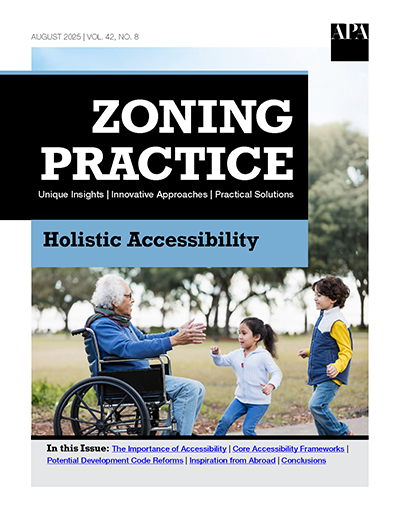Spotlight on Zoning Practice
Could Your Zoning Be Doing More to Promote Accessibility?

In many contexts, people are quick to point out the power of zoning to exclude certain groups. The flip side, though, is that zoning can also be a powerful tool for building more inclusive communities. While zoning reforms that broaden opportunities to increase housing supply are crucial, these aren't the only reforms that can support human flourishing. There are numerous potential ways to utilize zoning to make places, spaces, and homes more accessible to all people, regardless of age or ability.
As Jill Bahm, AICP, and Rose Kim note in the August issue of Zoning Practice, "Holistic Accessibility," zoning is an underutilized tool for promoting accessibility. Instead of merely ensuring that our parking standards comply with the Americans with Disabilities Act, we can integrate universal design principles into mandatory development standards and leverage zoning incentives to encourage developers to go beyond minimum requirements.
What's the 'Curb-Cut Effect' Lesson for Housing Standards?
Curb cuts are a classic example of a design intervention intended to benefit a specific population that winds up having a nearly universally positive effect. When we add ramps to sidewalks to provide wheelchair access, we make it easier for people pushing strollers, pulling rolling luggage, or using any other wheeled mobility device to get around.
So, what changes can we make to how we build housing that could unlock similar widespread benefits? Perhaps it's as simple as leveraging the concept of visitability. A visitable home includes features such as no-step entrances and first-floor amenities that make it possible for people of all life stages and abilities to comfortably visit a home. Furthermore, design techniques that promote visitability often make it easier to add other universal design features that can take a home from merely visitable to truly livable.
According to Bahm and Kim, many communities have integrated visitability standards into their residential building codes, while others use zoning to ensure a minimum percentage of residences in multi-unit developments include visitability or universal design features.
How Can We Connect the Dots Between Mobility and Accessibility?
Just as zoning standards don't need to be explicitly exclusionary to have an exclusionary effect, land use and development regulations don't need to include explicit references to access for those with disabilities to promote accessibility. For example, Bahm and Kim explain that the design of the local street network is core to helping people of all life stages, circumstances, and abilities access different parts of a community. Yet, standards that dictate block sizes or the ratio of links to nodes seldom explicitly reference universal design principles.
Bahm and Kim also note that standards that facilitate transit-oriented development, expand green infrastructure, or ensure that streets are designed to accommodate all modes of transportation can all be effective at removing barriers to access for people who may be "disabled" by common features in the built environment.
Subscribe to Zoning Practice

Each issue of Zoning Practice provides practical guidance for planners and land-use attorneys engaged in drafting or administering local land-use and development regulations. An annual subscription to ZP includes access to the complete archive of previous issues.
Top image: RAOUL RODRIGUEZ / iStock / Getty Images Plus


